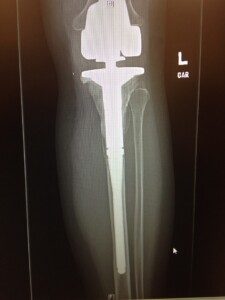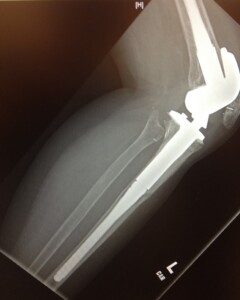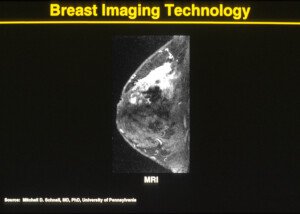
Ann developed excruciating shin pain below her knee while training for a marathon; it was cancer her doctor missed that was visible on an X-ray.
Though I may not look like it, I am what doctors refer to as a zebra.
In medical school, students are taught when hypothesizing a diagnosis, that “when you hear galloping, first assume horses, not zebras.”
I was diagnosed with a mostly pediatric bone cancer at age 43.
Age notwithstanding, I was treated on the pediatric cancer floor, where I looked like one of the moms — until I lost my hair and my hand was holding a wheeled pole with a payload of chemo.
In fact, my three daughters, 20, 15 and 11, were at home with friends while my husband, who was a marathon runner, held my not-IV’d hand.
Pain in Upper Leg Misdiagnosed As a Running Injury
My life as a zebra began in 2010. I was training for a marathon when my leg started hurting.
It was an odd pain that was served with a side dish of heat over the painful area.
The very odd thing about the pain was that it got worse at night while I was sleeping.
It would wake me with such excruciating pain that I would sit up and try to suppress a scream worthy of an axe-murder movie victim.
The crazy thing is the pain would be better in the morning, enough so that I would get on the treadmill and talk myself out of making an appointment with a doctor.
After a month or so, the suppressed scream wasn’t suppressible. I reluctantly and somewhat apologetically went to the doctor (of osteopathic medicine or DO) who passively diagnosed me with “being 43 and a runner.”
My take-home prescription was the equivalent of “walk it off”; stop training so hard and stretch.
It was the same spot every time: left leg, proximal tibia, so top of tibia.
Each time I would point to the same spot, and each time she said it was “referred pain,” and that the problem was my shin.
Ann’s doctor actually had ordered an X-ray – in August: eight months after Ann had first seen her.
She was hyperfocused on mid-tibia. She was disappointed that the X-ray did not show the typical “puff” that is evident with a stress fracture.
I was gifted a boot and crutches and told to not walk it off — but to stay off it.
Below is the X-ray. Even a layperson can easily see that there’s something at the top of the tibia bone, where it gets wider, that doesn’t seem to belong there. That more solid-looking and well-defined area is the cancer.

X-ray of Ann’s leg
Nine appointments and nine months later (September) I had stacked-up arthritis creams, prescription painkillers, muscle relaxants, sleep aids, foam rollers of all shapes and textures, and physical and massage therapy sessions like a hypochondriac.
Two weeks after being (mostly) obedient with the crutches, I woke up from another wildly painful night and couldn’t stand or walk — my leg just gave up.
Leg Pain Is Cancer
Finally, at my now unapologetic insistence, and promise to pay for the MRI should insurance not cover the cost (doctor said they wouldn’t; I said they would), an MRI revealed a large mass on my proximal tibia.
The mass was biopsied under general anesthesia a few days later at an entirely different hospital.
I woke up in the recovery room with my husband and surgeon at my bedside looking grim.
The diagnosis was pathologist-confirmed and indisputable: osteosarcoma (OS).
This brand of cancer is a primary bone tumor, made up of a matrix of bone-material that is unstable.
If you ever google a photo of an osteosarcoma tumor, you will see a spiny porcupine-like bony structure. No wonder it hurt so much!
This type of caner typically affects kids ages 10-20 when they are in a time of rapid bone growth.
There is no good theory (not sure there’s a bad one either) of why I would have gotten this cancer at age 43.
Back to the pediatric cancer floor, I was halfway through nearly a year of treatment when I was told it was “not going well” — the chemo wasn’t having the desired effect.
I asked my pediatric oncologist what was next if this treatment regimen didn’t work.
He responded, “There is nothing else for you; this has to work.”
Left alone for a few moments after that sobering conversation, I said a prayer, which was more of a plea: “God, use me,” however he wished, for whatever purpose he deemed me capable of.
As a result of that audacious request to “use me,” I started an organization called MIB Agents for kids with osteosarcoma.
Today, MIB Agents Osteosarcoma Alliance Makes It Better (MIB) in three main ways: Research, Programs, Education.
We do this not as patient advocates, but as advocates for all constituents of the disease community of doctors, researchers, patients, industry and families.
We include all parties in all aspects of our work, save for a doctor-only international virtual tumor board.
We work together. Progress is being made, and all of us in the OS community are due!
OS is the oldest known cancer, found in a 77-million-year-old dinosaur bone and in a humanoid foot, yet we have had no new treatments in nearly 50 years.
As for my original doctor, she moved to a different medical center after my nine-month misdiagnosis odyssey.
I hold no ill will for her. I only hope that she learned to not dismiss a patient’s persistent pain symptoms, listens to her patients and leaves space for the possibility of zebras.
How was Ann’s treatment successful?
For OS, you get that open biopsy (some surgeons do a core needle biopsy) on the area.
If it’s malignant, they sew you up and start chemo immediately, with the hopes that the tumor is mostly killed off by the copious amount of chemo.
You get two kinds of chemo simultaneously through a dual port. It is rough.
After three months, the surgeon goes in to remove the bone(s) affected through amputation or limb-salvage surgery.
I had limb-salvage, where my bones were replaced with titanium and allograft bone with donor tendon (see images below).

Ann’s reconstructed leg

Ann’s reconstructed leg
Sixteen hours later, you have a new leg. It doesn’t have the full functionality of your natural leg, but you do not have to take it off/put it on every day.
Post-surgery if your tumor necrosis is good, then you go back on the aforementioned chemo regimen for another 6-7 months.
If necrosis is not good — mine was not — at 40% necrosis– then high dose methotrexate is added to the chemo cocktail. I still had lung mets post-treatment, but those literally disappeared.
 Ann Graham began MIB Agents in 2012 when fellow patient Alyssa Divers was sent home on hospice for the same cancer. Ann rallied her friends to create an extraordinary experience for Alyssa and her family. Today, MIB Agents Makes It Better (MIB) for kids with osteosarcoma through direct patient and family support programs, educational materials and resources, funding research and through an annual conference, weekly podcast and webinar.
Ann Graham began MIB Agents in 2012 when fellow patient Alyssa Divers was sent home on hospice for the same cancer. Ann rallied her friends to create an extraordinary experience for Alyssa and her family. Today, MIB Agents Makes It Better (MIB) for kids with osteosarcoma through direct patient and family support programs, educational materials and resources, funding research and through an annual conference, weekly podcast and webinar.
.









































